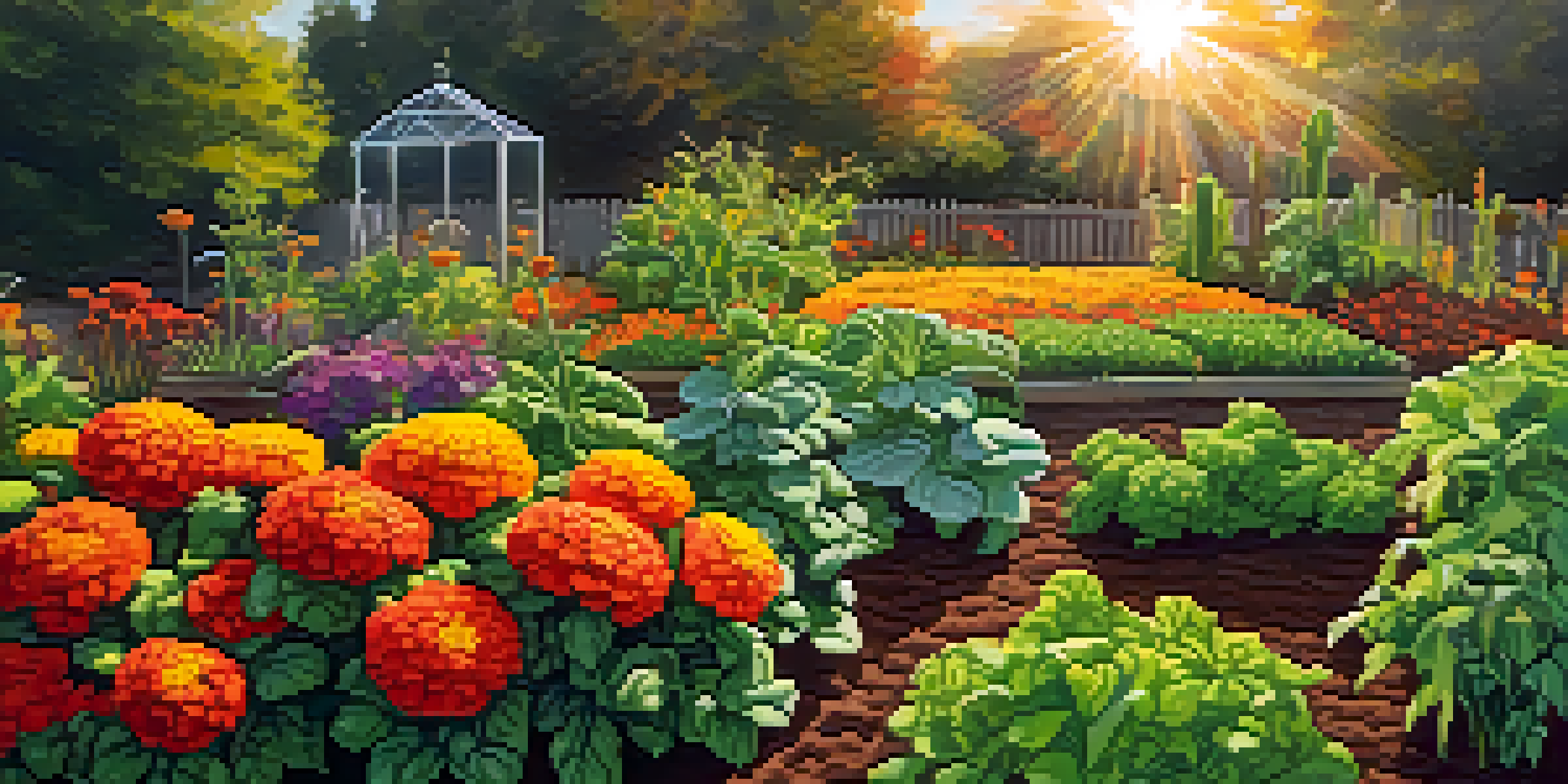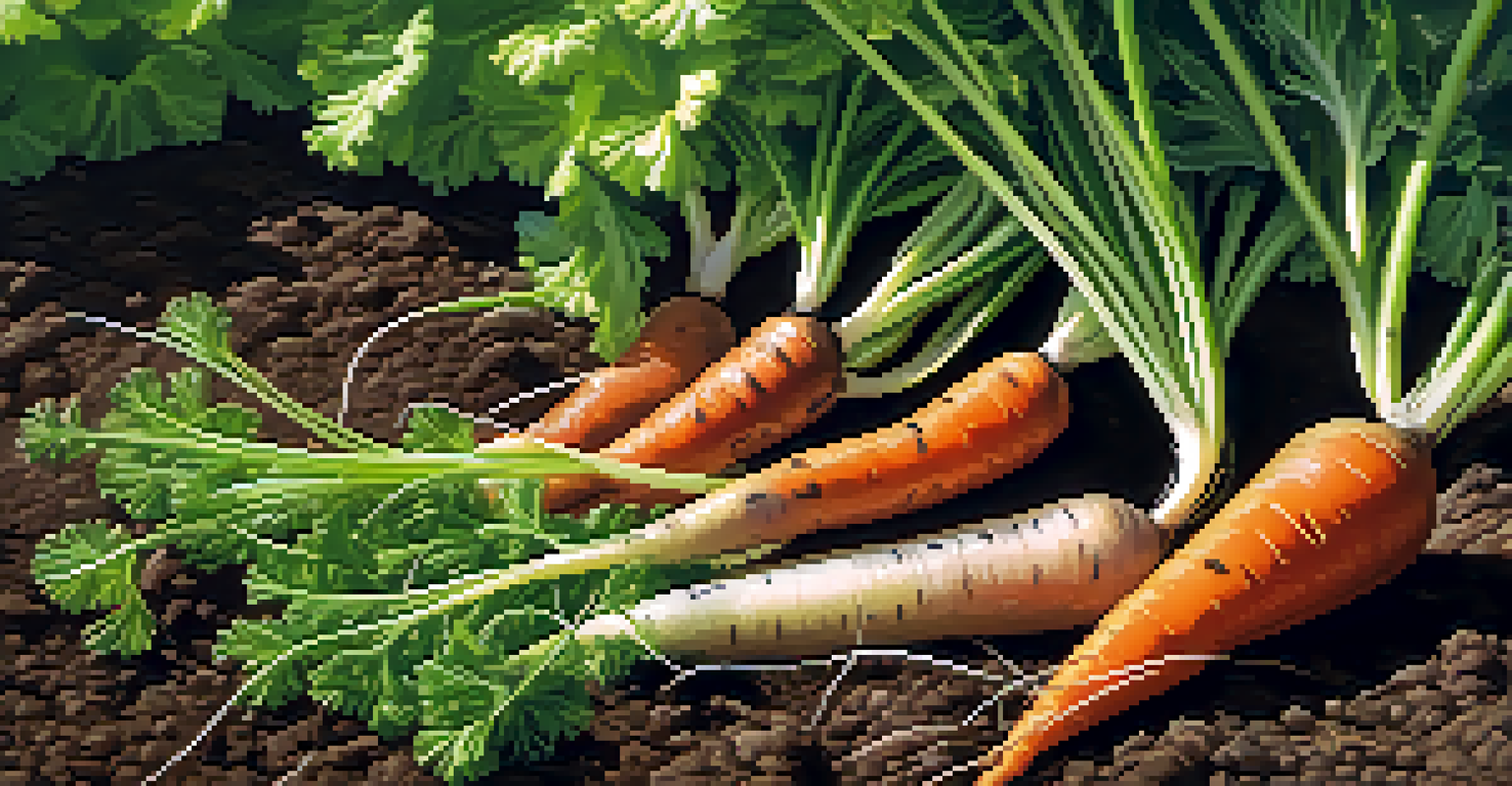Companion Planting: Enhancing Growth in Organic Gardens

What is Companion Planting and How Does It Work?
Companion planting is an age-old gardening technique that involves growing different plants together for mutual benefit. By strategically placing compatible plants in proximity, gardeners can enhance growth and deter pests naturally. This method mimics nature's way of creating balance in ecosystems, where diverse plant species support each other.
In nature, nothing exists alone.
For instance, planting basil alongside tomatoes can improve tomato flavor while repelling harmful insects. Similarly, the classic combination of carrots and onions helps mask each other's scents, reducing pest attraction. Understanding these relationships is key to harnessing the full potential of your garden.
Ultimately, companion planting is about creating a harmonious environment that fosters healthy plants and minimizes the need for chemical interventions. It's a simple yet effective strategy to enhance the overall productivity of your organic garden.
Benefits of Companion Planting for Organic Gardens
The advantages of companion planting extend far beyond just aesthetics. One of the most significant benefits is the natural pest control it offers, as certain plants can deter harmful insects that threaten your crops. For example, marigolds are known to repel nematodes and other pests, creating a protective barrier around more vulnerable plants.

Additionally, companion planting can improve nutrient uptake in the soil. Deep-rooted plants can bring nutrients from below the surface, making them available to shallow-rooted neighbors. This symbiotic relationship not only boosts plant health but also leads to richer, more fertile soil over time.
Companion Planting Enhances Growth
Growing compatible plants together boosts growth and naturally deters pests.
Moreover, companion planting can increase biodiversity, which is essential for a thriving ecosystem. By encouraging a variety of plants, you create a more resilient garden that can withstand pests and diseases more effectively. This diversity is particularly important in organic gardening, where chemical solutions are often limited.
Choosing the Right Companion Plants for Your Garden
Selecting the right companion plants can feel daunting, but it can be simplified with a bit of planning and research. Start by considering the growth habits and needs of your primary crops. For example, if you're growing leafy greens, you might pair them with herbs like dill or coriander, which can enhance their flavor and deter pests.
The greatest fine art of the future will be the making of a comfortable living from a small piece of land.
It's also essential to think about the size and growth rate of the plants. Taller plants can provide shade for shorter ones, while sprawling varieties can cover the ground, reducing weeds. A classic example is the combination of corn, beans, and squash - known as the 'Three Sisters' - where each plant supports the others in a beneficial way.
To make your selections easier, many gardening resources and books provide lists of compatible and incompatible plants. By referring to these guides, you can create a well-thought-out plan that maximizes the potential of your garden.
Common Companion Planting Combinations to Try
There are numerous tried-and-true combinations that have stood the test of time in the gardening community. One popular pairing is carrots and onions, which not only help each other grow but also keep pests at bay. Another great example is the combination of tomatoes and basil, which enhances both flavor and aroma while repelling harmful insects.
Another effective duo is cucumbers and radishes. The radishes grow quickly and can help break up the soil, making it easier for cucumbers to take root. Additionally, the radishes deter cucumber beetles, providing an added layer of protection for your plants.
Improves Soil and Nutrient Use
Deep-rooted plants can enhance nutrient availability for shallower-rooted neighbors.
For those looking to attract beneficial insects, consider planting flowers like borage or nasturtiums alongside your vegetables. These flowers not only add beauty to your garden but also draw in pollinators and predatory insects that help control pest populations.
How to Implement Companion Planting in Your Garden
Implementing companion planting is easier than it sounds and can be done in a few simple steps. Begin by designing your garden layout with companion plants in mind, ensuring that their needs align in terms of sunlight, water, and nutrients. Sketching a plan on paper can help visualize how plants will coexist and support each other.
Next, consider staggered planting times to optimize space and resources. By planting crops at different times, you can ensure that there’s less competition for nutrients and sunlight, allowing each plant to thrive. For instance, planting lettuce early in the spring and then following up with summer tomatoes can maximize your garden's productivity.
Finally, keep an eye on your garden as it grows. Observe how the plants interact and adjust your pairings if necessary. Gardening is a dynamic process, and being flexible will help you find the best combinations for your specific environment.
Troubleshooting Companion Planting Issues
Even with the best planning, you may encounter challenges when implementing companion planting. One common issue is the competition for space and resources, which can lead to stunted growth. To mitigate this, ensure that you plant appropriately spaced crops and consider their mature sizes to avoid overcrowding.
Another potential problem is pest attraction due to certain plant combinations. If you notice an influx of pests, it might be time to reassess your pairings. For example, if you find that your peppers are attracting pests when planted with certain flowers, try relocating them to a different part of the garden or switching up the companion plants.
Promotes Garden Biodiversity
A diverse garden is more resilient to pests and diseases, making it ideal for organic practices.
Lastly, keep an eye on plant health and growth patterns. If something seems off, don't hesitate to adjust your planting strategy. Gardening is a learning experience, and being attentive to your plants will help you fine-tune your companion planting approach for better results.
Conclusion: Embrace Companion Planting for a Thriving Garden
Companion planting is not just a popular trend; it's a sustainable practice that can significantly enhance the health and productivity of your organic garden. By understanding plant relationships and selecting the right companions, you can create a vibrant ecosystem right in your backyard. This approach not only boosts growth but also fosters a more resilient garden that requires fewer synthetic inputs.
As you experiment with different combinations, you'll discover what works best for your particular garden. Keep in mind that gardening is a journey filled with trial and error, and every garden is unique. Embrace the process and enjoy the fruits of your labor.

In the end, companion planting is about connecting with nature and nurturing the environment. So grab your seeds, get planting, and watch your garden flourish through the power of companionship!